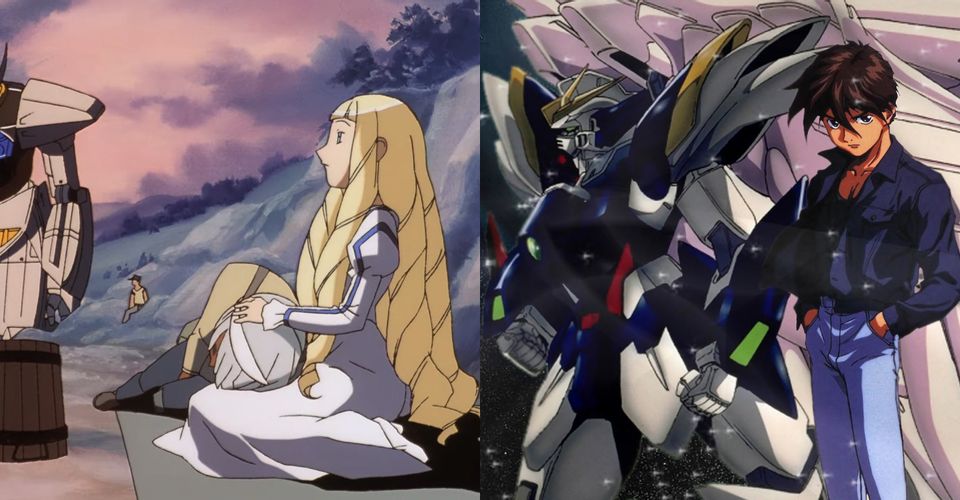Every Gundam Alternate Universe, Ranked By MyAnimeList

The classic mecha franchise Mobile Suit Gundam‘s biggest and most important continuity is the “Universal Century” timeline, which is the narrative that encompasses the original Gundam anime from 1979 and its many sequels. There’s a ton of material in that timeline, though, and getting into its later entries without a solid background in the universe can be intimidating.
Luckily, Gundam‘s producers are aware of that difficulty and have as such produced a wide variety of Gundam material that includes familiar themes from the franchise’s legacy content, while at the same time being disconnected from the mainline universe. These “alternate universes” have been met with varying degrees of success, with some being heralded as some of the best material the franchise has to offer, and others being left behind by anime history.
9 Gundam: G No Reconguista (5.76)

Gundam: G no Reconguista, or G-Reco as it’s more commonly referred to by fans, is an endlessly embattled anime in Gundam discussion spaces. In the run-up to its release expectations ran high thanks to some exceptionally beautiful mobile suit designs and artwork, and, most importantly, the return of franchise creator Yoshiyuki Tomino to the lead director’s chair. Upon release, though, the series was met with intensely mixed reviews.
Critics of the series maligned its breakneck pacing, lack of clear character motivations, and outright refusal to commit to any sort of expository world-building. Fast and confusing as it may have been, there’s still a dedicated contingent of fans out there who argue that G-Reco has the makings of a great show for those willing to bear with its unsteady pacing and dialogue.
8 Mobile Suit Gundam AGE (6.49)

AGE features a few intriguing gimmicks, the first and foremost of which was a generational approach to its story. Where a traditional Gundam narrative would use its 50 episodes or so to tell the stories of a handful of characters across a singular conflict, AGE chronicles the experiences of three consecutive generations across around 100 years of in-universe history.
Although that certainly sounded interesting at the time, AGE was unfortunately met with muted reception during its TV run, in part because of its experimental structure. Many fans at the time argued that compressing essentially three different storylines with different sets of characters into a single series harmed the pacing, and left little breathing room for the characters and setting.
7 After War Gundam X (7.32)

Gundam X is the underdog title of the ’90s Gundam alternate universes. It wasn’t quite different enough to set itself apart from legacy titles like G Gundam was, it didn’t enjoy mainstream commercial success outside of Japan like Wing did, and it lacked the unique creative drive that Yoshiyuki Tomino brought to Turn A. Indeed, Gundam X is to date the only Gundam title outside of the original 1979 anime that was canceled before it completed its original TV run, clocking in at just 39 episodes.
Despite its commercial failure, Gundam X has fans who ardently argue that it’s a criminally underrated entry in the franchise. It does feature a compelling setting, envisioning a post-apocalyptic environment where both sides in Gundam‘s perpetually recurring interplanetary war fought each other to near extinction. While it certainly doesn’t deserve a bad reputation, this anime does seem destined to be perpetually less popular than its counterparts.
6 Mobile Fighter G Gundam (7.56)

The first Gundam alternate universe is also one of its most unique. With serious creator and director Yoshiyuki Tomino’s interest and enthusiasm for the series waning thanks to the troubled production of the previous year’s Mobile Suit Victory Gundam, 1994 saw the franchise take steps in a bold new direction, and under new creative supervision.
Radically different from the grim realism and heady political drama of the Universal Century titles, Mobile Fighter G Gundam is about kung-fu warriors battling in an interplanetary giant robot tournament. The rule of cool transparently drove most of the team’s decisions during the production of G Gundam, and while it might not always make sense it is one of the most purely entertaining Gundam shows out there.
5 Turn A Gundam (7.70)

Turn A Gundam was the anime project produced for Gundam‘s 20th anniversary in 1999, and saw original series creator Yoshiyuki Tomino reprising his role as head director for the series. Bent on bringing something unique to the series, Tomino drew inspiration from Japanese folklore (namely the 9th-century classic, The Tale of the Bamboo Cutter), theatre, and novels like War of the Worlds to produce one of the most fascinatingly different Gundam titles the franchise has to offer.
The folkloric influences are transparent here, giving Turn A a dreamy quality not often found in stories about giant robots battling one another in the name of imaginary space politics. That surrealism is supported by a uniformly stellar soundtrack from the legendary Yoko Kanno (notable for her work on Cowboy Bebop, among other things) and some distinctive, love-them-or-hate-them, mobile suit designs. While Turn A certainly isn’t for everyone, it does follow its core thematic concepts to deliver some powerful conclusions about its own story, and about the metaseries as a whole. As a sort of capstone on Gundam‘s first two decades, and as a work emblematic of Tomino’s shifting creative sensibilities, it isn’t to be missed.
4 Mobile Suit Gundam Wing (7.71)

Wing remains one of the most internationally-recognized Gundam anime available, and was the introductory piece of Gundam media for many thousands of fans, especially for those who grew up in North America. Thanks to the anime’s success on Cartoon Network’s Toonami block from 2000 to 2002, American audiences got their first real taste of Gundam through the dubbed version of Wing. This legacy has inspired a powerful amount of nostalgia, and for many beginners who didn’t venture further into the franchise, Gundam begins and ends with Wing.
As such, separating Wing from its legacy in North America is somewhat difficult. What would we think of Wing had it not been the lucky title to fill out that all-important anime time slot in the early 2000s? It’s difficult to say, but regardless, Wing remains a very important part of Gundam‘s international legacy.
3 Mobile Suit Gundam Seed (7.77)

Seed and its sequel, Seed Destiny, are some of the most controversial entries in the franchise, with Destiny inspiring particularly intense reactions among longtime fans. To fans it’s “dramatic”, “intense”, and “thematically nuanced”, and to detractors it’s “soapy”, “incoherent”, and “lacking in-depth”. It’s, of course, impossible to end that debate here, but regardless of one’s opinion on it, Seed is a critically important part of Gundam‘s history.
For one, Seed is one of the most popular and enduringly successful Gundam titles out there, living on through devoted fans as well as consistently high sales for plastic model kits featuring the show’s powerful robots. Plus, Seed is essential viewing for any Gundam fan, if only so that they can properly align themselves in the unending fandom war over this anime.
2 Mobile Suit Gundam: Iron-Blooded Orphans (8.03)

Iron-Blooded Orphans is the most recent Gundam alternate universe, and the only AU to grace Netflix’s international streaming platform (alongside UC titles like Unicorn, and others), giving it an international reach that not many other entries in the franchise enjoy. The story follows an insurgent uprising of mercenary child soldiers as they attempt to secure a future for themselves at the expense of authorities bent on their exploitation.
Featuring a punchy screenplay from acclaimed writer Mari Okada and some exciting action sequences that place a heavy emphasis on melee combat, Iron-BloodedOrphans is a gritty, exciting, and occasionally tragic Gundam adventure.
1 Mobile Suit Gundam 00 (8.13)

Arguably one of the most successful alternate universes, Gundam 00 is a thoroughly political and deeply postmodern entry in the franchise, making it an attractive choice for beginners. Drawing inspiration from a number of real-world political conflicts, and bearing the sensibilities of the post-9/11 era, 00 features armed non-state actors, terrorism, and nuanced geopolitics. The show staunchly refuses to paint any of its characters in clear-cut “good guy” or “bad guy” terms, instead depicting a deadly competition between several complex interests groups.
While the first season of 00 is widely remembered as some of the best that Gundam has to offer, the second season is messier by nearly all accounts, lacking the deft pacing, thrilling twists, and grounded realism of the show’s first half. While consensus suggests that the entire project is still worth watching, newcomers should be aware that things do become less graceful as the show runs on.
About The Author

















